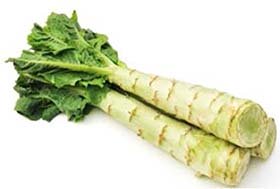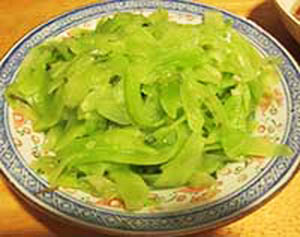Celtuce (Chinese lettuce) Nutrition facts
Celtuce (莴笋) or stem lettuce is a long, gnarly, firm, edible stem part of the L. sativa plant. Indeed, both its bitter, tender leaves and jade-green, succulent thick stems are fairly popular as cooked vegetables in mainland Chinese and Taiwanese cuisine. However, it's crisp, asparagus-flavored stems that take prudence over tufty top leaves in the rest of the world.
Scientific name: Lactuca sativa var. angustana or asparagina.
It is also called by names as celery-lettuce, asparagus-lettuce, Chinese lettuce, Wōsǔn, etc.
 |
| celtuce stems with top greens. image: MUSC Urban Farm. |
Botanically, lettuce is a Compositae (Asteraceae) family, cool-season, an annual herb native to the Mediterranean coast. It is a hybrid between celery (A. graveolens) and lettuce and its flavor is a reminiscence of both these vegetables.
Stem lettuce demands the same growth conditions as leaf lettuce. Nonetheless, this versatile plant is hardy and easy to grow because it tolerates wide temperature variations; high temperatures, and cold winters.
Plant the seeds a meter apart for better growth. The stems can be ready for harvesting when it reaches about 12-14 inches in length and 3-5 cm across, and before bolting.
Health benefits of Celtuce
Celtuce stems indeed are very low in calories. 100 g fresh stems carry just 18 calories. Nonetheless, this unique veggie contains impressive plant chemicals and anti-oxidants that possess health-promoting and disease-prevention properties.
In Traditional Chinese Medicine (TCM), celtuce is termed as bitter-flavor food, influencing the heart and small intestine organs. Its effect can be clearing heat from the body, stimulate appetite, and promote releasing actions like urination and bowel movements.
Fresh celtuce stems carry more fiber, folates and vitamin-C than leaf lettuce. Folates are part of co-factors in the enzyme metabolism required for DNA synthesis and therefore, play a vital role in the prevention of neural tube defects in the baby (fetus) during pregnancy.
100 g of fresh stem lettuce contains nearly twice the amount of vitamin C than leaf lettuce. This natural antioxidant helps boost immunity, fights against infectious agents and scavenges harmful pro-inflammatory free radicals from the human body.
Its fresh stems are an excellent source of several Vitamin-A and β-carotenes. Just 100 g of fresh, stem-lettuce provides 3,500 IU or 117% of daily required levels of vitamin A. Altogether, these compounds function as antioxidants, maintaining healthy mucosa and skin, and good vision. Research studies suggest that consumption of natural fruits and vegetables rich in flavonoids offers protection from lung and oral cavity cancers.
Fresh stems are good source of vitamin-K. Vitamin K has a potential role in bone metabolism which is thought to increase bone mass by promoting osteoblastic activity in the bone cells. It also has an established role in the Alzheimer's disease patients by limiting neuronal damage in the brain.
It carries comparably the same amounts of minerals like iron, calcium, magnesium, and zinc as leaf lettuce. Nonetheless, it possesses higher amounts of potassium (330 mg vs. 194 mg/100 grams) than leaf-lettuce. Potassium is an important component of cells and body fluids that helps control heart rate and blood pressure. The body uses manganese as a co-factor for the antioxidant enzyme superoxide dismutase. Copper is required in the production of red blood cells. Iron is essential for red blood cell formation.
Stem lettuce also possesses moderate concentrations of other B-complex groups of vitamins like thiamin, vitamin B-6 (pyridoxine), riboflavin, etc.
| Principle | Nutrient Value | Percent of RDA |
|---|---|---|
| Energy | 18 Kcal | 1 % |
| Carbohydrates | 3.65 g | 2.8% |
| Protein | 0.85 g | 1.5% |
| Total Fat | 0.30 g | 1% |
| Cholesterol | 0 mg | 0% |
| Dietary Fiber | 1.7 g | 4.5% |
| Vitamins | ||
| Folates | 46 µg | 11.5% |
| Niacin | 0.550 mg | 3.5% |
| Pantothenic acid | 0.183 mg | 3.5% |
| Pyridoxine | 0.050 mg | 4% |
| Riboflavin | 0.070 mg | 6% |
| Thiamin | 0.055 mg | 5% |
| Vitamin-A | 3500 IU | 117% |
| Vitamin-C | 19.5 mg | 32.5% |
| Electrolytes | ||
| Sodium | 11 mg | <1% |
| Potassium | 330 mg | 7% |
| Minerals | ||
| Calcium | 39 mg | 4% |
| Copper | 0.040 mg | 4% |
| Iron | 0.55 mg | 7% |
| Magnesium | 28 mg | 7% |
| Manganese | 0.688 mg | 11% |
| Phosphorus | 29 mg | 4% |
| Zinc | 0.27 mg | 2.5% |
Selection and storage
Use of Chinese stem lettuce among US households is primarily by the expatriate Chinese and Korean communities. Its popularity among locals and European consumers is gaining ground, albeit slowly.
You can find imported stem lettuce wrapped in thin-film wraps, particularly in the oriental vegetables and fruits sections. Look for the celtuce stems that feature smooth skin, and are short, firm, moisture-rich, and not curved. Its top greens shoot near its tip should be fresh, light green, and not wilted.
Avoid oversized, woody stems as they signal past their prime.
At home, place the purchased celtuce into a container filled with ice-cold water. Then mop dry using a soft towel to remove moisture, and then put them in the refrigerator with a damp paper towel to extend shelf-life.
Preparation and serving methods
To prepare, peel the stem's outer thick peel using a paring knife or vegetable peeler until you find a light green, moist edible "heart" of the celtuce at its core. They taste crispy, reminiscent of cauliflower/radish flavor in salads. Cooked in soups and stir-fries, its texture becomes somewhat mellowed yet chewy.
Use young, tender leaves in salad, or cook lightly.
 |
| Stir-fried stem lettuce Photo courtesy: Gary Stevens |
Here are some serving tips:
Raw, fresh sliced/julienned celtuce commonly added in salads.
Fresh stems commonly feature in Cantonese style stir-fries in garlic sauce with meat, prawns or chicken.
In mainland China and Taiwan, stem lettuce (wōsǔn) is also employed in pickling.
Its terminal shoots (AA choy), are also found used as greens in stir-fries and soups.
Safety profile
Like in leaf lettuce types, celtuce also contains moderate levels of oxalic acid. People with known oxalate urinary tract stone disease should try to avoid vegetables high in oxalic acid, like tomato, spinach, etc. (Medical disclaimer).
Also read ≻≻-
≻≻- Lettuce nutrition facts.
≻≻- Komatsuna nutrition facts.
≻≻-Back to Vegetables from Celtuce. Visit here for an impressive list of vegetables with complete illustrations of their nutrition facts and health benefits.
≻≻-Back to Home page.
Further Resources:
Watch your garden grow, University of Illinois Extension. (Link opens in new window).